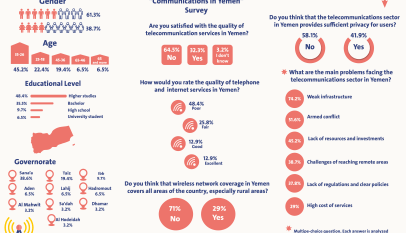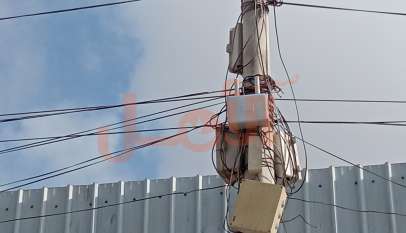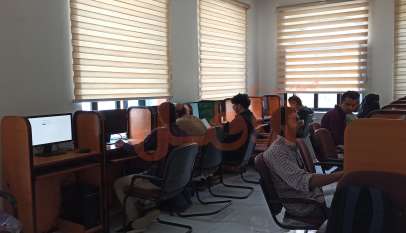The Telecommunications Infrastructure in Yemen: Challenges and Opportunities
Sawt Al-Amal (Voice of Hope) – Hebah Mohammed
The communications infrastructure, whether in terms of landlines, mobile phones or the internet network, is a fundamental element in achieving the economic and social development of any country. In Yemen, the communications infrastructure faces significant challenges that negatively impact its ability to meet the needs of society and achieve technological progress. These challenges include conflict, lack of investments, absence of legislation, and others. This report highlights the main challenges facing the communications infrastructure in Yemen, as well as the opportunities available for its improvement and development.
General Overview & Comprehensive Analysis
The telecommunications and information technology sector is witnessing rapid and significant developments in various fields, playing a vital role in the economic and developmental process. This contributes to raising the cultural, scientific, knowledge, and economic levels of societies, and works to improve the quality of life. It is essential for all relevant parties to focus on developing the communications and information technology infrastructure and work on its enhancement.
According to Engineer Ali Al-Sharmani (Head of the Wireless Access Department at the Ministry of Communications in Sanaa), “The telecommunications and information technology sector is a fundamental element in the infrastructure of the national economy, playing a decisive role in enhancing economic growth. In the previous years, especially before the conflicts since 2001, this sector witnessed rapid growth thanks to significant investments by the private sector and government institutions, aiming to keep pace with the developments of that period.”
He added that despite the destruction suffered by the telecommunications sector due to the conflict, and the extensive damage to its infrastructure, there are ongoing efforts to restore the service by the relevant authorities and to address the challenges through continuous work on updating the telecommunications infrastructure within the available capabilities, in line with modern communication systems.
The telecommunications and information technology sector in Yemen offers a variety of services targeting individuals, communities, and businesses. These services include wired communication through fiber optic and copper cables for both companies and individuals, as well as wireless communication and 4G services in most Yemeni cities and rural areas.
The “Yemen Wi-Fi” project was launched to provide wireless internet services at universities and government offices, aiming to facilitate affordable internet access for students and contribute to easier educational delivery.
Before the conflict, the state-owned telecommunications company and its subsidiary, TeleYemen, were the sole providers of internet services, with a significant investment in essential fiber optic infrastructure spanning approximately 13,000 kilometers, reaching major and secondary cities as well as numerous rural locations.
However, due to limited resources, there were only limited investments in the intermediate and final networks connecting the basic infrastructure to targeted cities and areas. The public telecommunications corporation had over 500,000 internet subscribers (residential and commercial) through an asymmetric digital subscriber line (SLAD) service, offering speeds of up to 4 megabytes per second.
The infrastructure in Yemen was susceptible to power outages before the ongoing crisis that began in 2015, resulting in frequent disruptions to communication and internet services. Plans to expand the infrastructure, including surplus networks, were halted due to the conflict and divisions within public communication companies.
Engineer Abdul-Latif Al-Akwa’, head of educational media at the General Institute of Communications, pointed out that the communication sector in Yemen has suffered significant damage due to ongoing conflicts in various important Yemeni provinces, leading to destruction and severe damage to roads, bridges, power stations, and water networks, which in turn affected the communication sector.
Al-Akwa’ also highlighted the potential for developing the communication sector in the coming years through the use of modern technology (Smart Cities) to improve the infrastructure in Yemen, including the use of remote sensing devices, data analysis, and internet devices to enhance information and quality services that meet the citizens’ needs, requiring the development of modern strategic plans and the identification of funding sources.
Digital Gap in Rural Areas
It is noted that approximately 75% of the population in Yemen resides in rural areas. Due to the difficult and rugged geographical nature of Yemen, as well as the scattered population in mountains, plains, and valleys, these factors and obstacles lead to what is known as the “digital gap,” meaning unequal communication services between rural and urban areas due to the difficulty of providing services to those areas.
It was emphasized that despite the natural and geographical obstacles, modern and advanced communication systems have been used in Yemen, including fourth-generation (4G) wireless communication systems, which often contribute to enhancing communication in rural and urban areas, despite the challenges they face.
The telecommunications services have been able to reach rural, remote, and distant areas, which were difficult to access using traditional wired communication systems. The “Yemen 4G” services have been launched, providing wireless communication and internet services with modern and advanced technologies at affordable prices to various Yemeni provinces. The use of modern technologies will reduce the digital gap between urban and rural areas, making communication and information technology services available to everyone in all Yemeni regions and cities.
Development Opportunities & Future Projects
Despite the challenges facing the telecommunications sector in Yemen, there are opportunities available to improve the infrastructure through joint efforts in rebuilding and developing it. This includes attracting foreign investments in the telecommunications sector to enhance the infrastructure, improve service quality, and develop legislation and laws that contribute to regulating the telecommunications sector and achieving economic and social development in Yemen.
The telecommunications sector is essential for the country’s development, requiring both governmental and private entities to plan and implement projects that align with the modern advancements in the global telecommunications and information technology field.
Engineer Abdul-Latif emphasizes the need for significant investments to rebuild and develop the damaged infrastructure, along with international support to enhance basic services for citizens.
The Ministry of Communications and Information Technology is making significant efforts to improve the telecommunications and information technology infrastructure, adapting to the modern era’s developments, addressing all challenges, and introducing the best global communication systems and technologies.
According to National Information Center, the strategic vision of the Ministry of Communications and Information Technology (2002-2025), in developing the telecommunications infrastructure, may help overcome the difficulties facing the telecommunications sector in Yemen. The vision and proposed plan were developed in 2002 to address the challenges by increasing the required capacity of the fixed telephone network to over 5.5 million lines by 2025, achieving a penetration rate of 15 lines per 100 inhabitants.
The center also published that the number of computer devices in use should reach 6.2 million by 2025, with an increase in internet subscribers to an average of 260 subscribers per 10,000 inhabitants, and the number of hosts at a rate of 70 per 10,000 inhabitants. National Information Center also reported that Public Telecommunications Corporation has made a massive investment in its fiber optic network, with coverage reaching approximately 85% of Yemen’s governorates. Efforts are currently underway to complete coverage in the remaining areas, emphasizing the importance of securing telephone heat and data messaging networks through the establishment of multiple paths (Rings).
74.2% of Respondents in the Survey See the Lack of Infrastructure as One of the Most Prominent Problems Facing the Telecommunications Sector in Yemen
Sawt Al-Amal (Voice of Hope) – Yomna Ahmed The telecommunications sector is one of the mo…












